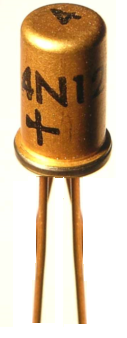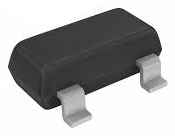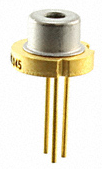Types of Diodes

Many different types of diodes today are in use in electronics.
The different kinds each have their own specialized uses. Some diodes, such as zener diodes, function as voltage regulators because when reverse bias is fed it above a certain point, the diode maintains a constant voltage across its terminals. Other diodes, such as varactors, function as variable capacitors, because the junction capacitance changes in response to the reverse-bias voltage supplied to the diode.
We will now go over the main types of diodes and what their use is.
Zener Diodes

A Zener Diode is a special type of diode that
is used most
extensively as a voltage regulator; this is because, in reverse bias, once the reverse voltage supplied
to a zener diode reaches its breakdown voltage, referred to as VZ, the voltage across the diode
remains constant at this voltage
even if the current through the diode continues to increase or vary. With this constant voltage across its terminals,
a load just has to be connected in parallel with the zener diode to receive this steady voltage. Zener diodes can
provide many different types of steady voltages, as they are manufactured with many different levels of breakdown voltages.
Schottky Diodes

A schottky diode is a diode that has a very low forward-voltage drop and very fast switching times. The fast switching times makes them useful in applications
of fast clamping and high-frequency applications approaching the gigahertz range.
Shockley Diodes

A shockley diode is another diode which is used primarily for switching applications. The shockley diode has an inherent trigger voltage. If the voltage applied across it is lower
than the trigger voltage, the diode does not switch on and has extremely high resistance in a circuit. If the voltage is applied is greater than the trigger voltage, then the shockley diode
switches on and has very low resistance.
Varactors

A varactor is a diode whose junction capacitance can be altered with an applied reverse voltage.
For this reason, a varactor is also called a variable capacitance diode (also it's called a varicap). A varactor's capacitance varies as the applied reverse voltage to it changes. As the applied reverse voltage increases, the width of its junction increases, which decreases its capacitance. Conversely, as the applied reverse voltage decreases, the width of its junction decreases, which increases capacitance.
The capacitance changes which varactors allow make them of broad use in oscillator circuits, where capacitance needs to be tuned to a precise capacitance value.
Therefore, varactors have widespread use in tuning circuits where a change in capacitance tunes the circuit.
LEDs

The LED, which stands for Light-Emitting Diode, is one of the most popular and known type of diode. It is a diode which emits light when it receives sufficient forward current flowing through it.
LEDs come in many different types of colors and types. There are blinking LEDs which flashes on and off a certain amounts of times per unit time. There are tri color LEDs,
which can emit two different colors depending on which lead receives positive voltage. And there are infrared LEDs which emit infrared light, which are used heavily in remote controls.
Laser Diodes

Laser diodes are diodes that emit a very narrow wavelength spectrum and, thus, can focus radiation to a spot as small
as 1micrometer
in
diamteter. Compared to LEDs, laser diodes have very quick response times and a narrow beam spectrum. Laser diodes are used in CD players, CD-ROM drives, and other optical storage drives. They are also used in laser printers, laser
fax machines, laser pointers, bar code scanners, and high-performance imagers.
Photodiodes

A photodiode is a diode which generates a current when exposed to light. In utter darkness, they act as an open circuit, allowing no current to pass through. When the light they are exposed to becomes bright, they conduct current across from their cathode to anode. Photodiodes, like zener diodes, connect to a circuit in reverse bias. This means that the cathode of the diode is connected to the positive voltage and the anode to the negative voltage. When the light intensity increases, current flows from the cathode to anode. Current increases with light intensity.
Photodiodes have very fast response times (in the nanoseconds).
Fast Reovery Diodes

Fast recovery diodes are diodes which have quick recovery times.
One important task which a diode has many times in a circuit to rectify AC signals so that they can become DC signals, to power devices which need DC voltage. The normal frequency coming out of a US outlet is 60Hz. A certain amount of finite time is required for a diode to recover from each AC signal cycle to the next. This is the time it takes for a diode to turn off when the polarity of the applied voltage is reversed. This is normally just a fraction of a second. In low-frequency applications, the recovery time of a diode is not particularly significant, since the cycles are not very fast. However, in high-frequency applications, each successive cycle happens quicker and quicker. Therefore, it becomes necessary for a diode to recover quicker. The diode recovery time becomes crucial.
A fast recovery diode is a diode which can recover quickly from each AC cycle polarity reversal. A conventional diode could produce erratic output in these high-frequency situations.
A fast recovery diode ensures much more accurate representation and signal integrity when dealing with high-frequency signals.
Related Resources
How to Test a Diode
Diode Resistance- Explained
Diode Approximations- Explained
What is an Ideal Diode?
